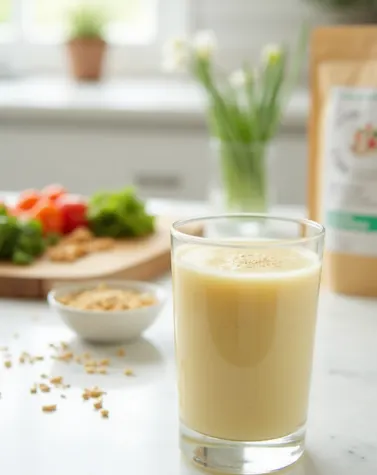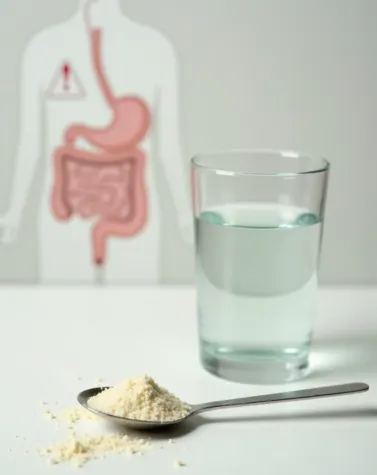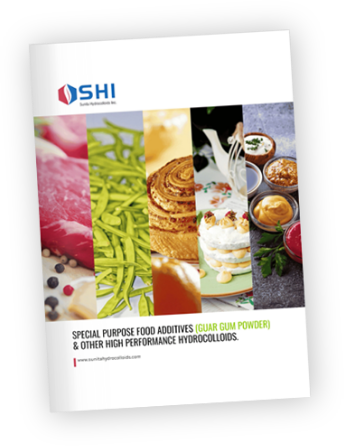
Thickening vs. Gelling: What’s the Difference in Food Ingredients?
Hydrocolloids are high-molecular-weight polymers, like starches and proteins, that play a key role in how your food feels to eat. People often lump “thickening” and “gelling” together because they both change a food’s texture. But, these two functions are actually quite different. Let’s break down the science behind them, look at some common ingredients, and see where they’re used.
The Science of Thickening: Getting Thicker
Thickening is about making a liquid more viscous without creating a solid structure. A thickening agent’s main job is to slow down the flow of a liquid, making it feel heavier and more resistant to movement. This gives you a thick but pourable liquid like gravy, sauce or soup.
This process happens when hydrocolloid molecules interact with water. When these large polymer chains spread out in a liquid, they hydrate and swell, taking up more space. The swelling and intertwining of these chains physically block water molecules and other particles. The result is more internal friction in the liquid and a higher viscosity. The important thing here is that there’s no permanent, three-dimensional network. The molecules are just tangled up. They can still move past one another if you apply enough force, which is a property many sauces have.
Common Thickening Agents:
- Starches (Cornstarch Flour Tapioca): These polysaccharides thicken through gelatinization. When you heat them in water the starch granules absorb the liquid, swell and then break open. This releases their components and makes the surrounding fluid thicker.
- Xanthan Gum: This is a bacterial polysaccharide that creates very viscous solutions even when you use a little bit of it. Its long rigid helical polymer chains tangle easily, making it a great thickener and stabilizer for things like salad dressings and sauces.
- Guar Gum: This polysaccharide comes from guar beans. It works as an effective thickener for both hot and cold liquids.
The Science of Gelling: Getting Sturdy
Gelling is the process that turns a liquid into a semi-solid, elastic, and self-supporting mass. Unlike thickening, gelling creates a continuous three-dimensional polymer network that traps and holds a lot of liquid inside. The final material, a gel, has both solid like and liquid like properties.
The gelation process is more complicated. It starts with hydrocolloid molecules hydrating in a liquid. Then when conditions change (like cooling, a different pH or adding certain salts or sugars) the polymer chains start to connect with one another. This connection is driven by weak forces that form “junction zones” which link the polymer chains. These form a stable three-dimensional network that acts like a sponge, holding the liquid inside and stopping it from flowing.
Common Gelling Agents:
- Gelatin: This protein comes from animal collagen. It forms a thermo-reversible gel meaning it gels when it cools and melts when it heats up. It gives you that smooth melt in your mouth texture.
- Pectin: You find this polysaccharide in fruits, especially citrus peels and apples. Pectin needs specific conditions, like sugar and acid, to form a gel. It is the main gelling agent you find in jams jellies and marmalades.
- Agar-Agar: This polysaccharide is from red algae. It is famous for forming a strong firm thermo-reversible gel that melts at a much higher temperature than gelatin. Many vegetarians and vegans use it as an alternative gelling agent.
- Carrageenan: This is a family of polysaccharides from red seaweed. Different types (kappa iota lambda) create different gel textures from firm and brittle to soft and elastic.
The Big Differences and a Quick Recap
The main difference between thickening and gelling is the final state of the food and how the molecules behave.
| Feature | Thickening | Gelling |
| Physical Result | A viscous pourable liquid | A semi-solid elastic gel |
| Molecular Mechanism | Polymer entanglement and swelling; molecules can still move | Polymer chains cross link to form a stable 3D network |
| Function in Food | Controls flow and mouthfeel (e.g. gravies soups) | Gives structure and form (e.g. jellies puddings) |
| Common Ingredients | Starches, Xanthan Gum, Guar Gum, Cellulose Gum | Gelatin, Pectin, Agar-Agar, Carrageenan |
| Example Products | Sauces salad dressings liquid soups | Jams jellies gummy candies panacotta |
A Special Note from Sunita Hydrocolloids Pvt. Ltd.
Knowing the small but important differences between thickening and gelling is at the heart of what we do. Our wide range of hydrocolloids including different grades of Guar Gum and Modified Starches are made to give you precise viscosity and stability for many applications. Our Purified Tamarind Seed Gum is a great example of a versatile hydrocolloid. It can act as both a thickening and gelling agent to create the perfect texture for your product.
Explore More on Hydrocolloids
If you’re curious about how specific hydrocolloids compare or function in food applications, check out these in-depth articles:
- Guar Gum: A Versatile Thickening Agent
Learn how Guar Gum enhances viscosity and stability across various food systems. - Guar Gum vs. Agar-Agar: Texture and Function Compared
Discover the differences between these two popular gelling agents and their unique applications. - Carrageenan vs. Guar Gum: Gelling Properties Explained
Understand how these hydrocolloids differ in texture, stability, and ideal use cases.





